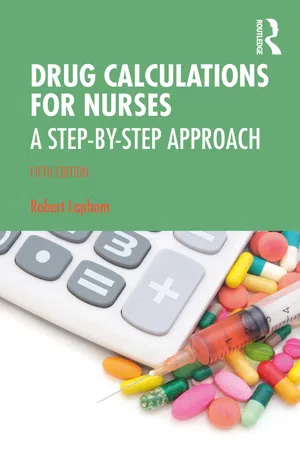
- 402 pages
- English
- ePUB (mobile friendly)
- Available on iOS & Android
About this book
This new edition of Drug Calculations for Nurses teaches healthcare professionals how to perform drug calculations with confidence and competence. It provides step-by-step guidance to carry out accurate drug calculations, with units and drug strengths clearly explained.
This bestselling pocket-size book begins with the basic mathematical skills required to perform calculations, including tips on estimating answers. It then covers drug strengths and concentrations, dosage calculations, IV infusion therapies, and pharmacodynamics and pharmacokinetics. Separate chapters focus on children, adults and the elderly, addressing specific challenges encountered in these populations, with new content on pregnancy, and renal and liver function. Helpful worked examples, key points, and objectives are included in every chapter, and this new edition includes more calculations for prescribing and patient-focused scenarios. The companion website, www.drugcalcsnurses.co.uk, provides a comprehensive test bank, with a pre-test and revision test to identify strengths and weaknesses, along with additional practice questions for readers to test themselves on.
Designed for students and practitioners in nursing, midwifery and allied health, this textbook enables readers to improve their numeracy skills for clinical practice and develop their understanding of the broader context for these calculations.
Frequently asked questions
- Essential is ideal for learners and professionals who enjoy exploring a wide range of subjects. Access the Essential Library with 800,000+ trusted titles and best-sellers across business, personal growth, and the humanities. Includes unlimited reading time and Standard Read Aloud voice.
- Complete: Perfect for advanced learners and researchers needing full, unrestricted access. Unlock 1.4M+ books across hundreds of subjects, including academic and specialized titles. The Complete Plan also includes advanced features like Premium Read Aloud and Research Assistant.
Please note we cannot support devices running on iOS 13 and Android 7 or earlier. Learn more about using the app.
Information
PART I
- Basics
1
INTRODUCTION
HOW TO USE THIS BOOK
BEFORE WE START
NUMERACY
Table of contents
- Cover
- Half Title
- Title Page
- Copyright Page
- Contents
- List of Figures
- List of Tables
- Preface
- Part I
- Part II
- Part III
- Appendices
- Index